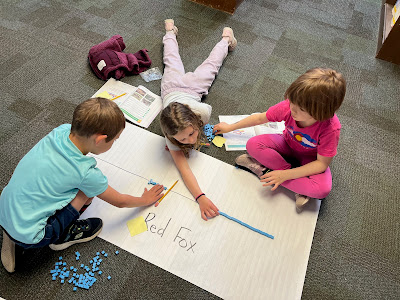Wednesday, April 30, 2025
VINS Field Trip Coming Soon!
On Friday, May 16th, first grade will be traveling by bus to the Vermont Institute of Natural Science in Quechee, linking an amazing local resource with our in class learning. Our EL unit is entitled “Growing as Researchers: Birds Amazing Bodies.” The program at VINS will include a live raptor program and learning about bird adaptations. Permission slips for this learning adventure will be in Thursday folders next week. Please sign and return the permission slip as soon as possible. There is also a spot on the form to indicate whether or not your child will need a school bag lunch (PBJ) or will be bringing a bag lunch from home.
Monday, April 28, 2025
Literacy: Informational Reading and Writing and Multisyllabic Words
We have moved into a new unit in Literacy with a focus on Writing to show our research: building expertise about bird's bodies. Students will study a specific bird to learn about how the key parts help it survive in its habitat. Within expert groups, students use the National Geographic kids text: First Big Book of Birds for Little Kids to answer the unit guiding question: How do specific birds use their body parts to survive.
Unit 12 shifts our word study focus from sounds to syllables. Students are being taught to read and spell two-syllable words with closed syllables (napkin, public) , including compound words (catnap, backpack). Heart words for this unit include: people, month, little, been, own, want, Mr. Mrs.
Math: Linear Measurement
Students began a new unit in math focused on linear measurement. Unit goals include measuring length and counting up to 120 length units and solving addition and subtraction story problems with unknowns in all positions. Last week, mathematicians are measuring the length of objects by iterating length units (connecting cubes, centimeter cubes, paperclips), comparing lengths of objects, and exploring longer than and shorter than language. They learned the conventions of length measurement and representing measurements with a number and the name of the length unit, gaining understanding that the length measurement of an object is the number of same-size length units that span it without gaps or overlaps. This week, students are solving compare, add to, and take from story problems about measurement.
Thursday, April 3, 2025
Literacy: Resarch, Informational Reading and Writing, V-C-E Syllables
First Graders are engaging in small group research using the text, “Beaks” by Sneed Collard. Students are reading, writing and talking about the text as they answer the research question, “How do birds use their beaks to survive?” During the next week students will engage in a series of beak challenges. Their learning from this portion of the unit will culminate in an individual writing piece about birds beaks.
During word study students have learned a new syllable pattern: vowel-consonant-e. V-C-E syllables are syllables that contain a vowel, consonant, and silent e pattern, resulting in a long vowel sound (hike, bake). First Graders continue to practice reading with accuracy and prosody during our daily fluency block. Please practice the following heart words at home: friend, other, another, none and nothing.Math: Addition Within 100 by Making 10
First graders continue to grow their understanding of place value this week, applying what they learned about adding one-and two-digit numbers to any numbers within 100, with and without composing a ten (regrouping). Students apply the associative and commutative properties as they count on, add tens and tens, and add ones and ones. Students see that no matter which order they use to combine parts of the addends, the sum remains the same. They continue to use, interpret, and connect different methods and representations (including equations) that show a new unit of ten being composed from 10 ones.
Second Step: Fair Ways to Play
The third lesson in our Second Step problem solving unit focused on fair ways to play this week. Students explored the idea of sharing, trading, or taking turns as a solution for solving problems. They gained experience with defining and differentiating the terms, identifying and stating the problem for a given solution, generating possible solutions, and demonstrating fair ways to play. Sharing, trading, and taking turns are solutions intended to promote the goals of fairness and mutual enjoyment, so students are less likely to use aggressive solutions.

































